4. Stream API
4.1 Introduction
The MediaStreamMediaStream
Each MediaStream
Each track in a MediaStream object has a corresponding
MediaStreamTrack
A MediaStreamTrack
A channel is the smallest unit considered in this API
specification.
A MediaStreamMediaStreamgetUserMedia() call (which is
described later in this document), for instance, might take its input
from the user's local camera. The output of the object controls how the
object is used, e.g., what is saved if the object is written to a file or
what is displayed if the object is used in a video
element.
Each track in a MediaStream
A MediaStream
The output of a MediaStream
A new MediaStreamMediaStream()
constructor. The constructor argument can either be an existing
MediaStreamMediaStreamMediaStreamTrack

Both MediaStream
MediaStreamTrack objects can be cloned. This allows for
greater control since the separate instances can be manipulated and
consumed individually. A cloned
MediaStream contains clones of all member tracks from the
original stream.
When a MediaStreamMediaStream object is also used in contexts outside
getUserMedia, such as [WEBRTC10]. In both cases, ensuring
a realtime stream reduces the ease with which pages can distinguish live
video from pre-recorded video, which can help protect the user's
privacy.
A MediaStreamTrackMediaStreamTrackgetUserMedia()
.
Note that a web application can revoke all given permissions
with MediaStreamTrack.stop().
A MediaStreamTracknew prior to being connected to
an active source.
Once connected, the started event fires and the track
becomes live. In the live state, the track is
active and media is available for rendering at a
MediaStream consumer.
A muted or disabled MediaStreamTrack
MediaStreamTrack object is both unmuted and enabled.
A MediaStreamTrack
MediaStream, received via a RTCPeerConnection
[WEBRTC10], is muted if the application on the other side
disables the corresponding track in the MediaStream being
sent.
Applications are able to enable or
disable a MediaStreamTrack
For a newly created MediaStreamTrack
A MediaStreamTrack
When a MediaStreamTrackstop() method being invoked on the
MediaStreamTrack
-
If the track's readyState attribute
has the value ended already, then abort these steps.
-
Set track's readyState attribute to
ended.
-
Fire a simple event named ended at the object.
If the end of the stream was reached due to a user request, the event
source for this event is the user interaction event source.
4.3.2 Tracks and Constraints
Constraints are independent of sources. However, if
the sourceType is "none",
the readonly attribute
is true, or the remote
attribute is true, the track's constraints will
not be applied to the source.
Whether MediaTrackConstraints
Each track maintains an internal version of
the MediaTrackConstraintsMediaTrackConstraintsMediaTrackConstraintSet, MediaTrackConstraint,
and similarly-derived-type dictionary objects.
When track constraints change, a user agent must queue a task to evaluate those changes
when the task queue is next serviced. Similarly, if
the sourceType
changes, then the user agent should perform the same actions to
re-evaluate the constraints of each track affected by that
source change.
4.3.3 Interface Definition
interface MediaStreamTrack : EventTarget {
readonly attribute DOMString kind;
readonly attribute DOMString id;
readonly attribute DOMString label;
attribute boolean enabled;
readonly attribute boolean muted;
attribute EventHandler onmute;
attribute EventHandler onunmute;
readonly attribute boolean _readonly;
readonly attribute boolean remote;
readonly attribute MediaStreamTrackState readyState;
attribute EventHandler onstarted;
attribute EventHandler onended;
static sequence<SourceInfo> getSourceInfos ();
MediaTrackConstraints? constraints ();
MediaSourceStates states ();
(AllVideoCapabilities or AllAudioCapabilities) capabilities ();
void applyConstraints (MediaTrackConstraints constraints);
attribute EventHandler onoverconstrained;
MediaStreamTrack clone ();
void stop ();
};4.3.3.1 Attributes
enabled of type boolean, -
The MediaStreamTrack.enabled
attribute, on getting, MUST return the last value to which it was
set. On setting, it MUST be set to the new value, and then, if the
MediaStreamTrack
Note
Thus, after a MediaStreamTrackenabled attribute still
changes value when set; it just doesn't do anything with that new
value.
id of type DOMString, readonly -
Unless a MediaStreamTrackid attribute to that string.
An example of an algorithm that specifies how the track id must be
initialized is the algorithm to represent an incoming network
component with a MediaStreamTrack
MediaStreamTrack.id attribute MUST return the value
to which it was initialized when the object was created.
kind of type DOMString, readonly -
The MediaStreamTrack.kind
attribute MUST return the string "audio" if the object
represents an audio track or "video" if object represents
a video track.
label of type DOMString, readonly -
User agents MAY label audio and video sources (e.g., "Internal
microphone" or "External USB Webcam"). The MediaStreamTrack.label
attribute MUST return the label of the object's corresponding track,
if any. If the corresponding track has or had no label, the attribute
MUST instead return the empty string.
Note
Thus the kind and label attributes do not
change value, even if the MediaStreamTrack
muted of type boolean, readonly -
The MediaStreamTrack.muted
attribute MUST return true if the track is muted, and false otherwise.
onended of type EventHandler, - This event handler, of type
ended, MUST be supported by
all objects implementing the MediaStreamTrack onmute of type EventHandler, - This event handler, of type
mute, MUST be supported by
all objects implementing the MediaStreamTrack onoverconstrained of type EventHandler, - This event handler, of type
overconstrained, MUST be supported by
all objects implementing the MediaStreamTrack onstarted of type EventHandler, - This event handler, of type
started, MUST be supported by
all objects implementing the MediaStreamTrack onunmute of type EventHandler, - This event handler, of type
unmute, MUST be supported by
all objects implementing the MediaStreamTrack readonly of type boolean, readonly -
If the track (audio or video) is backed by a read-only
source such as a file, or the track source is a local
microphone or camera, but is shared so that this track
cannot modify any of the source's settings, the
readonly
attribute MUST return the value true.
Otherwise, it must return the value false.
readyState of type MediaStreamTrackState, readonly -
The readyState
attribute represents the state of the track. It MUST return the value
to which the user agent last set it.
remote of type boolean, readonly -
If the track is sourced by
an
RTCPeerConnection, the remote
attribute MUST return the value true.
Otherwise, it must return the value false.
4.3.3.2 Methods
applyConstraints-
This API will replace all existing constraints with the
provided constraints (if existing constraints
exist). Otherwise, it will apply the newly provided
constraints to the track.
| Parameter | Type | Nullable | Optional | Description |
|---|
| constraints | MediaTrackConstraints | ✘ | ✘ | A new constraint structure to apply
to this track. |
capabilities-
Returns a dictionary with all of the capabilities for the
track type. If the track type is VideoStreamTrackAllVideoCapabilities
dictionary is returned. If the track type
is AudioStreamTrackAllAudioCapabilities
Given that implementations of various hardware may not
exactly map to the same range, an
implementation should make a reasonable attempt to
translate and scale the hardware's setting onto the mapping
provided by this specification. If this is not possible due
to the user agent's inability to retrieve a given
capability from a source, then for CapabilityRange-typed
capabilities, the min and max
fields will not be present on the returned dictionary, and
the supported field will
be false. For CapabilityList"notavailable" value
will be the sole capability in the list.
Note
An example of the user agent providing an alternative
mapping: if a source supports a hypothetical
fluxCapacitance state whose type is a CapabilityRange, and
the state is defined in this specification to be the range
from -10 (min) to 10 (max), but the source's (hardware
setting) for fluxCapacitance only supports values of "off"
"medium" and "full", then the user agent should map the
range value of -10 to "off", 10 should map to "full", and
0 should map to "medium". Constraints imposing a strict
value of 3 will cause the user agent to attempt to set the
value of "medium" on the hardware, and return a
fluxCapacitance state of 0, the closest supported
setting. No error event is raised in this
scenario.
CapabilityList
See the AllVideoCapabilitiesAllAudioCapabilities
No parameters.
clone-
Clones the given MediaStreamTrack
When the clone() method
is invoked, the user agent MUST run the following steps:
-
Let trackClone be a newly constructed
MediaStreamTrack object.
-
Initialize trackClone's id attribute to a newly
generated value.
-
Let trackClone inherit this track's underlying
source,
kind,
label and
enabled
attributes.
-
Return trackClone.
No parameters.
constraints-
Returns the complete constraints object associated with the
track. If no mandatory constraints have been defined,
the
mandatory field will not be present (it will be
undefined). If no optional constraints have been defined,
the optional field will not be present (it will be
undefined). If neither optional, nor mandatory constraints have been
created, the value null is returned.
No parameters.
getSourceInfos, static-
Returns authorized information for all available sources.
No parameters.
states-
Returns an object containing all the state variables
associated with the allowed constraints.
No parameters.
stop-
When a MediaStreamTrackstop() method
is invoked, if no source is attached
(e.g., sourceType is "none"), then this
call returns immediately (e.g., is a no-op). Otherwise, the
user agent MUST queue a task that runs the following steps:
-
Let track be the current
MediaStreamTrack
-
End track. The track starts
outputting only silence and/or blackness, as appropriate.
-
Permanently stop the generation of data for track's
source. If the data is being generated from a live source (e.g.,
a microphone or camera), then the user agent SHOULD remove any
active "on-air" indicator for that source. If the data is being
generated from a prerecorded source (e.g. a video file), any
remaining content in the file is ignored.
The task source for the tasks
queued for the stop() method is the DOM
manipulation task source.
No parameters.
enum MediaStreamTrackState {
"new",
"live",
"ended"
};| Enumeration description |
|---|
new | The track type is new and has not been initialized
(connected to a source of any kind). This state implies that
the track's label will be the empty string. |
live |
The track is active (the track's underlying media source is making
a best-effort attempt to provide data in real time).
The output of a track in the live state can be
switched on and off with the enabled attribute.
|
ended |
The track has ended (the track's underlying media source is
no longer providing data, and will never provide more data for this
track). Once a track enters this state, it never exits it.
For example, a video track in a
MediaStream
|
4.3.4 Track Source Types
enum SourceTypeEnum {
"none",
"camera",
"microphone"
};| Enumeration description |
|---|
none | This track has no source. This is the case when the
track is in the "new" or "ended"
readyState. |
camera | A valid source type only for
VideoStreamTrack |
microphone | A valid source type only for
AudioStreamTrack |
4.3.6 Video Facing Mode Enum
enum VideoFacingModeEnum {
"user",
"environment",
"left",
"right"
};| Enumeration description |
|---|
user | The source is facing toward the user (a self-view camera). |
environment | The source is facing away from the user (viewing the
environment). |
left | The source is facing to the left of the user. |
right | The source is facing to the right of the user. |
4.5 Video and Audio Tracks
The MediaStreamTrackMediaStreamTrack
Note that the camera's green light
doesn't come on
when a new track is created; nor does the user get prompted to
enable the camera/microphone. Those actions only happen after
the developer has requested that a media stream
containing "new" tracks be bound to a source
via getUserMedia(). Until that point tracks
are inert.
4.5.1 VideoStreamTrack interface
Video tracks may be instantiated with optional media track
constraints. These constraints can be later modified on the
track as needed by the application, or created after-the-fact
if the initial constraints are unknown to the application.
Note
Example: VideoStreamTrack
new VideoStreamTrack();
or
new VideoStreamTrack( { optional: [ { sourceId: "20983-20o198-109283-098-09812" }, { width: { min: 800, max: 1200 }}, { height: { min: 600 }}] });
[Constructor(optional MediaTrackConstraints videoConstraints)]
interface VideoStreamTrack : MediaStreamTrack {
static sequence<DOMString> getSourceIds ();
};
4.5.1.1 Methods
getSourceIds, static-
Returns an array of application-unique source
identifiers. This list will be populated only with local
sources whose sourceType
is "camera"
and if allowed by the user-agent, "readonly"
variants of the former two types. The video source ids
returned in the list constitute those sources that the
user agent can identify at the time the API is called (the
list can grow/shrink over time as sources may be added or
removed). As a static
method, getSourceIds can be queried
without instantiating
any VideoStreamTrackgetUserMedia().
Issue 1
Issue: This information
deliberately adds to the fingerprinting surface of the
UA. However, this information will not be identifiable
outside the scope of this application and could also be
obtained via other round-about techniques
using getUserMedia().
No parameters.
4.5.2 AudioStreamTrack
Note
Example: AudioStreamTrack
new AudioStreamTrack();
or
new AudioStreamTrack( { optional: [ { sourceId: "64815-wi3c89-1839dk-x82-392aa" }, { gain: 0.5 }] });
[Constructor(optional MediaTrackConstraints audioConstraints)]
interface AudioStreamTrack : MediaStreamTrack {
static sequence<DOMString> getSourceIds ();
};
4.5.2.1 Methods
getSourceIds, static- See definition of
getSourceIds on
the VideoStreamTrackAudioStreamTracksourceType
is "microphone" and if allowed by the
user-agent, "readonly" microphone
variants.No parameters.
5. The model: sources, sinks, constraints, and states
Browsers provide a media pipeline from sources to sinks. In
a browser, sinks are the <img>, <video> and
<audio> tags. Traditional sources include camera,
microphones, streamed content, files and web resources. The
media produced by these sources typically does not change over
time - these sources can be considered to be static.
The sinks that display these sources to the user (the actual
tags themselves) have a variety of controls for manipulating the
source content. For example, an <img> tag scales down a
huge source image of 1600x1200 pixels to fit in a rectangle
defined with width="400"
and height="300".
The getUserMedia API adds dynamic sources such as microphones
and cameras - the characteristics of these sources can change in
response to application needs. These sources can be considered
to be dynamic in nature. A <video> element that displays
media from a dynamic source can either perform scaling or it can
feed back information along the media pipeline and have the
source produce content more suitable for display.
Note
Note: This sort of feedback loop is
obviously just enabling an "optimization", but it's a
non-trivial gain. This optimization can save battery, allow
for less network congestion, etc...
Note that MediaStream sinks
(such as <video>, <audio>,
and even RTCPeerConnection) will continue to have
mechanisms to further transform the source stream beyond that
which the states, capabilities,
and constraints described in this specification
offer. (The sink transformation options, including
those of RTCPeerConnection, are outside the scope of
this specification.)
The act of changing or applying a track constraint may affect
the state of all
tracks sharing that source and consequently all down-level sinks
that are using that source. Many sinks may be able to take these
changes in stride, such as the <video>
element or RTCPeerConnection. Others like the
Recorder API may fail as a result of a source state change.
The RTCPeerConnection is an interesting object
because it acts simultaneously as both a
sink and a source for over-the-network
streams. As a sink, it has source transformational capabilities
(e.g., lowering bit-rates, scaling-up or down resolutions,
adjusting frame-rates), and as a source it could have its own
states changed by a track source (though in this specification
sources with the remote attribute set to
true do not consider the current constraints applied to a
track).
To illustrate how changes to a given source impact various
sinks, consider the following example. This example only uses
width and height, but the same principles apply to any of
the states exposed
in this proposal. In the first figure a home client has obtained
a video source from its local video camera. The source's width
and height state are 800 pixels by 600 pixels,
respectively. Three MediaStreamsourceId. The three media streams are
connected to three different sinks: a <video>
element (A), another <video> element (B), and
a peer connection (C). The peer connection is streaming the
source video to an away client. On the away client there are two
media streams with tracks that use the peer connection as a
source. These two media streams are connected to
two <video> element sinks (Y and Z).
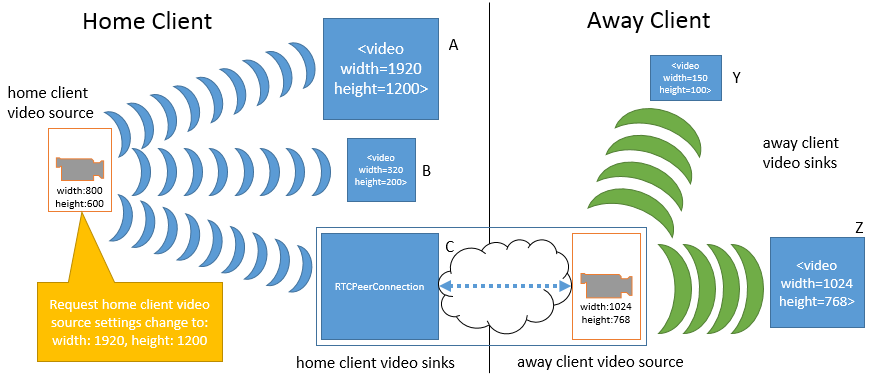
Note that at this moment, all of the sinks on the home client
must apply a transformation to the original source's provided
state dimensions. A is scaling the video up (resulting in loss
of quality), B is scaling the video down, and C is also scaling
the video up slightly for sending over the network. On the away
client, sink Y is scaling the video way down, while sink Z is
not applying any scaling.
Using the constraint APIs, the
home client's video source is changed to a higher resolution
(1920 by 1200 pixels).
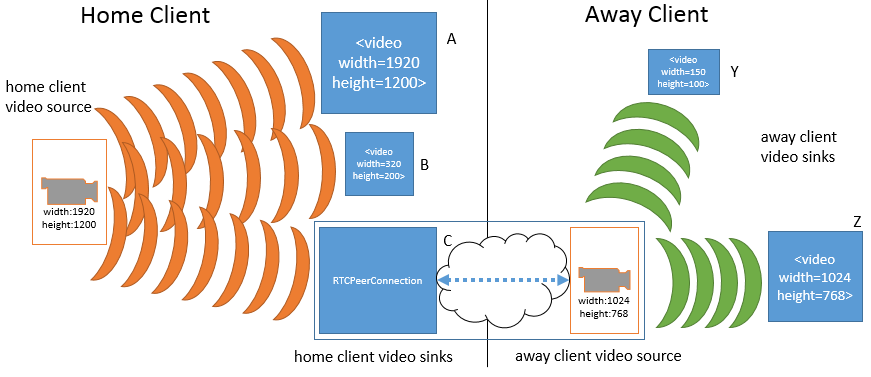
Note that the source change immediately affects all of the
sinks on the home client, but does not impact any of the sinks (or
sources) on the away client. With the increase in the home
client source video's dimensions, sink A no longer has to
perform any scaling, while sink B must scale down even further
than before. Sink C (the peer connection) must now scale down
the video in order to keep the transmission constant to the away
client.
While not shown, an equally valid states change request
could be made of the away client video source (the peer
connection on the away client's side). This would not only
impact sink Y and Z in the same manner as before, but would also
cause re-negotiation with the peer connection on the home client
in order to alter the transformation that it is applying to the
home client's video source. Such a change would
not change anything related to sink A or B or the home
client's video source.
Note that this specification does not define a
mechanism by which a change to the away client's video source
could automatically trigger a change to the home client's
video source. Implementations may choose to make such
source-to-sink optimizations as long as they only do so within
the constraints established by the application, as the next
example demonstrates.
It is fairly obvious that changes to a given source will
impact sink consumers. However, in some situations changes to a
given sink may also be cause for implementations to adjust the
characteristics of a source's stream. This is illustrated in the
following figures. In the first figure below, the home client's
video source is sending a video stream sized at 1920 by 1200
pixels. The video source is also unconstrained, such that the
exact source dimensions are flexible as far as the application
is concerned. Two MediaStreamsourceId, and
those MediaStream<video> element sinks A and B. Sink
A has been sized to width="1920"
and height="1200" and is displaying the source's
video content without any transformations. Sink B has been sized
smaller and, as a result, is scaling the video down to fit its
rectangle of 320 pixels across by 200 pixels down.
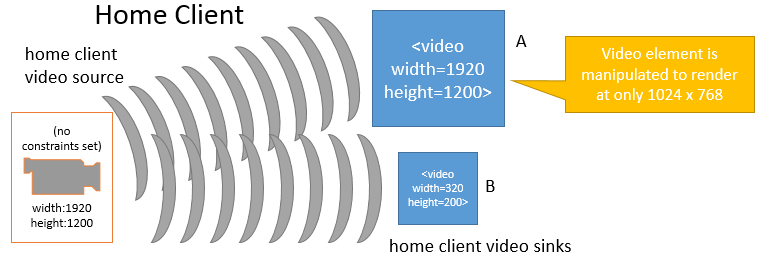
When the application changes sink A to a smaller dimension
(from 1920 to 1024 pixels wide and from 1200 to 768 pixels
tall), the browser's media pipeline may recognize that none of
its sinks require the higher source resolution, and needless
work is being done both on the part of the source and on sink
A. In such a case and without any other constraints forcing the
source to continue producing the higher resolution video, the
media pipeline MAY change the source resolution:
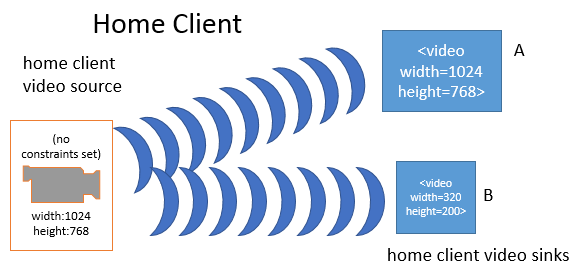
In the above figure, the home client's video source
resolution was changed to the greater of that from sinkA and
from sinkB in order to optimize playback. While not shown above,
the same behavior could apply to peer connections and other
sinks.
It is possible that constraints can be applied to a track
which a source is unable to satisfy. When this happens, the user
agent is required to fire an "overconstrained" event to the
track informing it of this condition, and the track becomes
muted. There is no mandatory side-effect on the source itself as
a result of this condition.
When multiple tracks share the same source (as illustrated in
the previous figures), it is also possible that two (or more)
tracks can apply contradictory constraints on the source. Since
there is only a single thread of control, it is always possible
for the browser to determine which track created the
overconstrained condition. In this situation, the user agent
MUST send the "overconstrained" event only to the track that
created the condition and MUST not apply any of the constraints
newly requested for that track. Here is an example of this
behavior.
In this example, two media streams each have a video track
that share the same source. The first track has a mandatory
constraint forcing on the source's fill light. That track is
connected to sink N. Sink N has a width and height of 800 by 600
pixels and is scaling down the source's resolution of 1024 by
768 to fit. The other track initially has no constraints
applied; it is connected to sink P. Sink P has a width and
height equal to that of the source.

Now, the second track adds a mandatory constraint that the
fill light should be forced off. At this point, both mandatory
constraints cannot be satisfied by the source (the fill light
cannot be simultaneously on and off at the same time). The
second track is transitioned into the muted state and receives
an "overconstrained" event. At the same time, the source notes
that its remaining active sink only requires a resolution of 800
by 600 and so it adjusts its resolution down to match (this is
an optional optimization that the user agent is allowed to make
given the situation).
At this point, it is the responsibility of the application to
fix the problem that led to the overconstrained situation (by
either removing the fill light mandatory constraint on the
second track, or by changing/removing the fill light mandatory
constraint on the first track).
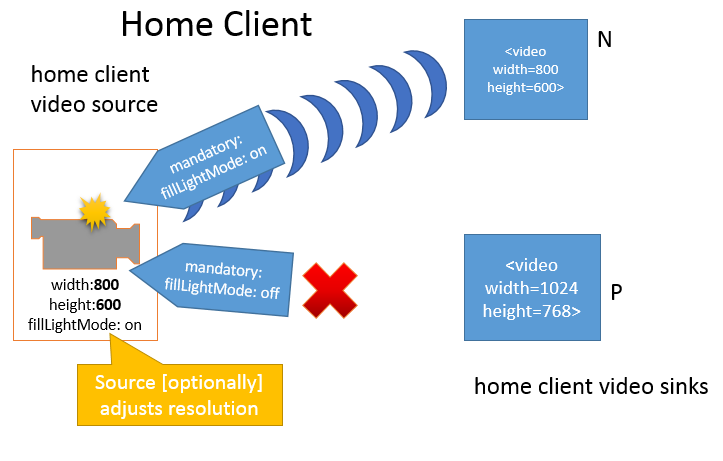
11. Obtaining local multimedia content






